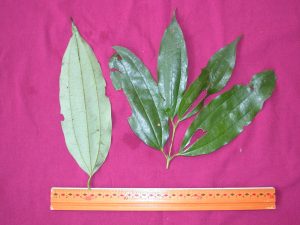
Caryodaphnopsis is a small genus of the Lauraceae. It contains 16 known species with a disjunct tropical amphi-Pacific distribution; 8 species in tropical Asia and 8 species in tropical America. Prof. LI Jie and his team of Xishuangbanna Tropical Botanical Garden (XTBG) previously investigated the phylogeny of the Persea group (Lauraceae) and its amphi-Pacific disjunction using the LEAFY gene. Their study indicated that the second intron of LEAFY was an excellent molecular marker for resolving phylogenetic relationships at lower taxonomic levels in Lauraceae due to its relatively high level of variation.
In a recent study, they chose RPB2 and LEAFY along with the universal ITS as molecular markers for phylogenetic reconstruction of the genus Caryodaphnopsis. They aimed to explore the phylogenetic utility of RPB2 and LEAFY in Caryodaphnopsis and related Lauraceae; and to place Caryodaphnopsis phylogenetically within the family. They further wanted to investigate the biogeographic history of Caryodaphnopsis focusing on its tropical amphi-Pacific distribution.
The researchers analyzed RPB2, LEAFY and ITS sequences of 9 Caryodaphnopsis species and 22 other Lauraceae species with maximum parsimony and Bayesian inference. They employed the Bayesian Markov chain Monte Carlo method to estimate the divergence time under a relaxed clock. By using both the statistical dispersal-vicariance analysis and likelihood approach under the dispersal-extinction-cladogenesis model, they conducted ancestral area reconstructions.
The phylogenetic analysis showed that the monophyly of Caryodaphnopsis was strongly supported. Within the Caryodaphnopsis clade, the Asian and American species each formed well-supported clades. The divergence of Caryodaphnopsis from the rest of Lauraceae was estimated as about 96.8 million years. The estimated divergence time between Asian and American Caryodaphnopsis was about 48 million years.
Based on the results, the researchers suggested that Caryodaphnopsis originated in Late Cretaceous Laurasia and its amphi-Pacific disjunction resulted from the disruption of ancestral boreotropical lineages between Eurasia and North America during the first cooling period of the Eocene.
The study entitled “Phylogeny and biogeography of Caryodaphnopsis (Lauraceae) inferred from low-copy nuclear gene and ITS sequences” has been published online in Taxon.
Reference:
Li, Lang; Madriñán, Santiago; Li, Jie, Phylogeny and biogeography of Caryodaphnopsis (Lauraceae) inferred from low-copy nuclear gene and ITS sequences. DOI: 10.12705/653.1
Note: The above post is reprinted from materials provided by Chinese Academy of Sciences.










